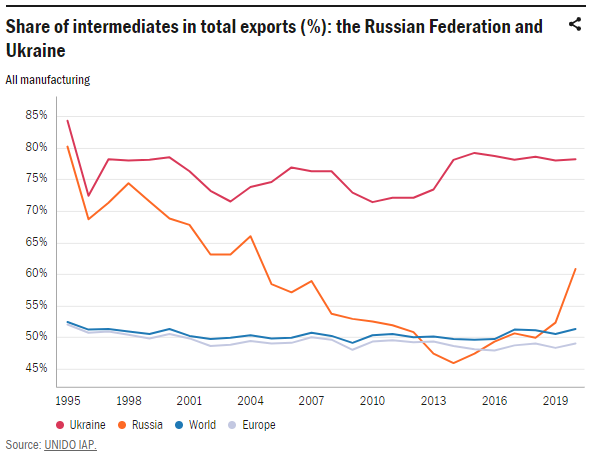

Global value chains in times of multiple crises
17 August 2022 Nicola Cantore, Alejandro Lavopa and Niki Rodousakis

Originally published on UNIDO’s Industrial Analytics Platform.
In our globalized world, production has become increasingly interconnected across borders. The rise of global value chains (GVCs) implies that the production of today’s manufactured goods hinges on inputs supplied from different corners of the world. Such fragmentation of production increases global efficiency as each country focuses on and specializes in the components it produces best. Yet fragmentation also bears risks: when an unexpected event disrupts production in a given location, its ripple effects quickly spread across borders, with a potentially serious impact on the global production of a number of goods. The effects are even more severe if the disruption occurs in a location that contributes strategic inputs in several value chains.
The COVID-19 pandemic vividly showcased the risks of GVC disruptions. Using survey data from 26 countries, UNIDO’s Industrial Development Report (IDR) 2022 finds that 71 per cent of firms experienced input shortages following the outbreak of the pandemic. This figure jumped to 77 per cent for firms that participate in global or regional value chains.
The armed conflict in Ukraine has exacerbated the disruptions in global production networks. Both Ukraine and the Russian Federation are highly integrated in global production. One common measure of GVC integration is the share of intermediate goods in total manufacturing exports. Accordingly, both countries are among the largest exporters of intermediate goods (figure below). The conflict’s ripple effects are likely to affect all value chains the two countries participate in.

Disruptions to GVCs can occur at two different levels. On the one hand, they can be crosscutting, simultaneously affecting several value chains. The armed conflict in Ukraine, for example, is having an impact on the availability of energy and other key commodities, such as food and minerals, and consequently on their prices. The conflict’s crosscutting effects will likely be severe, considering that both the Russian Federation and Ukraine are major exporters of energy and commodities. Trade disruptions in the two countries have had a global impact through price hikes—notably of energy goods—which in turn have affected transport costs and thus practically all GVCs (1).
A sharp rise in the global price of energy, food and fertilizers is already observable (figure below). According to the World Bank, the armed conflict in Ukraine could cause the largest commodity price shock since the 1970s (2).
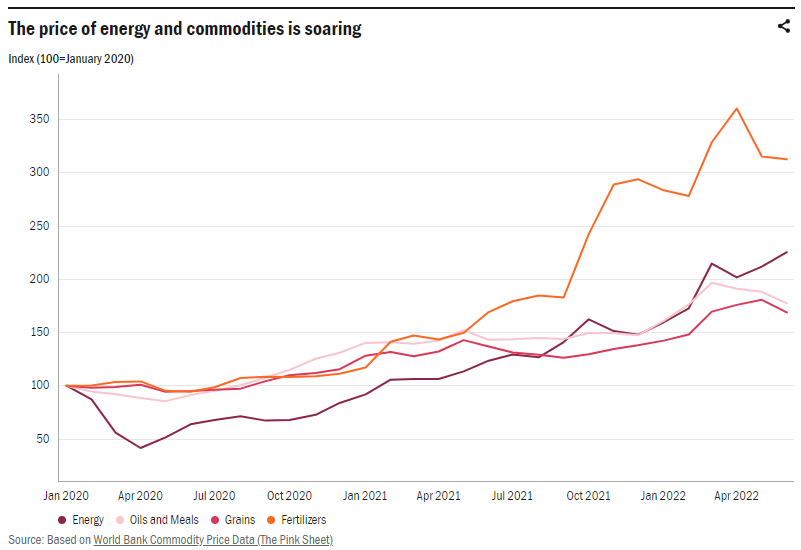
The conflict’s impact on commodities prices has triggered a global food crisis. Food shortages, especially grains and edible oils, and the resultant food price inflation are affecting consumers worldwide. Food insecurity, particularly in Africa and less developed countries, is rising dramatically.
On the other hand, disruptions can occur in a location that produces strategic inputs, which spread downstream through the value chain, affecting the subsequent stages and eventually bringing the production of certain goods to a standstill. Two examples from the current crisis are semi-finished iron products and wiring harnesses.
Semi-finished iron products are available in various sizes, grades and forms to meet the distinct requirements of different industries. They are used in the production of many common use goods such as vehicles, refrigerators and cutlery. According to the GMK Center, exports of semi-finished products by Ukrainian steel plants dropped by 60.08 per cent between January and June 2022; meanwhile, the European Union has banned the import of rolled metal and pipes from the Russian Federation. The Russian Federation and Ukraine are, respectively, the first and second biggest global exporters of semi-finished iron (figure below). As reported in the Financial Times, the armed conflict is causing major challenges for European firms, which are facing input shortages and rising prices, and are scrambling to find alternative suppliers.
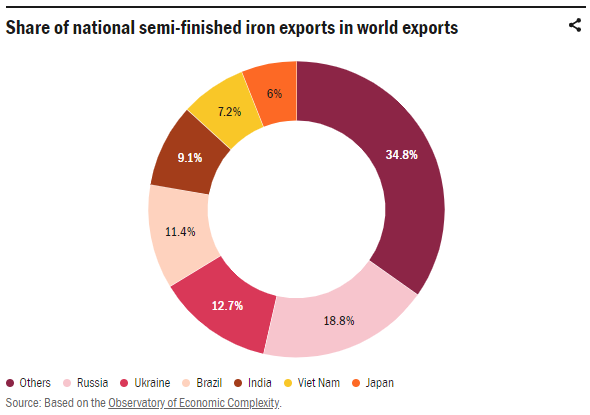
Ukraine is a leading supplier of wiring harnesses, an essential component in automotive electrical systems, to several European countries, including Czechia, Germany, Poland and Romania (see figure below) (3). The effects of the current shortage of wiring harnesses are already cascading through automotive supply chains around the world. For example, the production of automotive parts in Germany’s Leoni AG, Japan’s Fujikura Ltd and France’s Nexans, which all depend on Ukrainian wiring harness imports, has consequently either come to a complete standstill or has decreased significantly, which, in turn, has had a direct impact on European car manufacturers, including BMW, Opel and the Volkswagen Group (4).
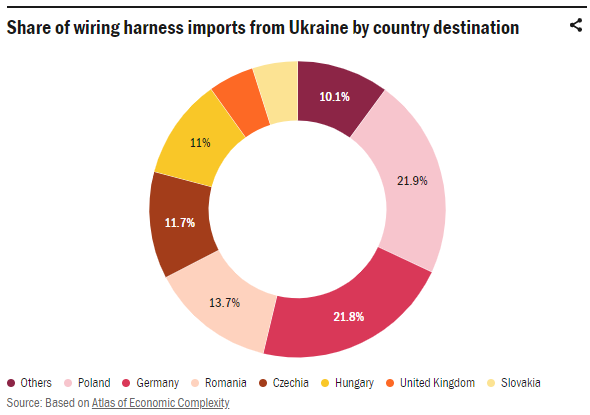
Responding to disruptions: Efficiency, substitution and resilience
Countries, industries and firms can adopt various approaches to deal with disruptions of this nature (i.e. shortage of specific inputs or increases in the price of materials and/or energy).
A rise in prices translates into an increase in firms’ production costs. The flipside is that high prices often prompt firms to optimize input use—that is, to enhance production efficiency—and/or to phase out existing energy sources (e.g. by replacing fossil fuels with renewable energy), or to substitute certain materials with alternative sources. Efficiency and substitution are key drivers of the green transition.
Recent UNIDO research finds that an increase in fuel prices is not necessarily detrimental to the competitiveness of firms in developing countries in the medium- to long term. In fact, rising fuel prices had a positive effect on manufacturing firms’ productivity and profitability in Mexico and Indonesia. Higher fuel prices induce firms to scrap old fuel-powered machinery and to purchase new electric equipment that is more productive and energy efficient. For example, a 10 per cent rise in fuel costs resulted in an increase in total factor productivity (TFP) of 1.6 per cent in Indonesia and 1.4 per cent in Mexico. Manufacturing firms’ profitability grew by 14 per cent in Indonesia and 18 per cent in Mexico. In other words, a rise in fuel prices induces firms to remain competitive by boosting their energy efficiency and replacing fuel with other energy sources. Insufficient use of electricity over fuel is one of the obstacles preventing developing countries from increasing the penetration of renewable energy sources (5).
Data on Indian manufacturing firms collected by UNIDO during the COVID-19 pandemic provide interesting insights as well. Among a sample of around 400 manufacturing firms, 80 per cent experienced input shortages as a result of the corona crisis. Asked about the three main strategies implemented to deal with these shortages, one-third of all firms stated that they were substituting raw materials and/or using alternative inputs (figure below). Around one-fifth introduced process innovations to address the input shortages. Hence, GVC disruptions can in fact spur input substitution and improve production efficiency.
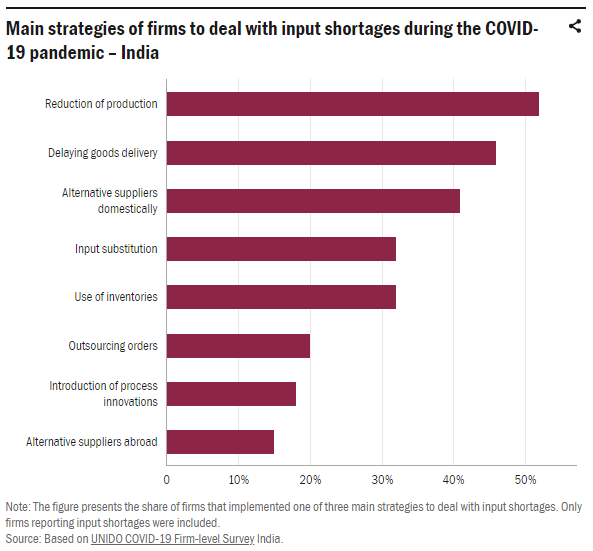
Value chain disruptions can open up an opportunity for firms to rethink their business model with the aim of mitigating and/or effectively responding to unexpected shocks, which is key to strengthening firm resilience (6).
Firm-level data collected by UNIDO reveal an interesting pattern across firms in developing and emerging economies in Africa, Asia and Latin America. Firms that experienced input shortages at the height of the pandemic were more likely, on average, to pursue transformational changes to respond to the crisis. The three major measures firms implemented to mitigate the impact of the crisis were: 1) introduction of new equipment to reduce the number of workers needed on the shop floor; 2) conversion of production to address the health emergency (repurposing); and 3) release of new products to meet changing market demands. The share of firms initiating such changes was higher among those that faced input shortages (figure below).
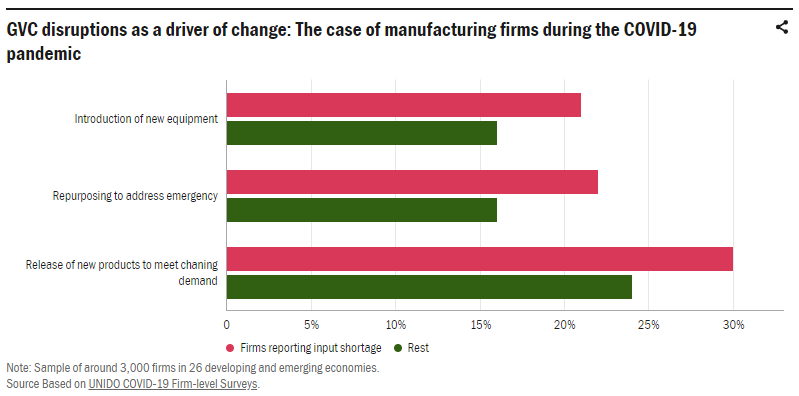
Policy implications
The shortage of and increase in the price of energy, materials, food and key components has unleashed severe disruptions in regional and global value chains. Inertia and lack of action are the most detrimental strategy firms can adopt to deal with such crises. When the necessary inputs to produce manufactured goods are unavailable or if they become extremely costly, firms must either start using such inputs more efficiently or replace them with alternatives. This will likely require either a partial or radical adaption of firms’ business models by introducing far-reaching process-, product- or organizational innovations.
Data indicate that many firms around the world have already shifted their focus towards the three keywords for action mentioned above: (1) efficiency; (2) substitution, and (3) resilience. Implementing these actions is fraught with challenges, however, with firms potentially experiencing market failures or a lack of the right incentives. Hence, governments carry the immense responsibility of creating the appropriate market conditions.
Policies need to be tailored around the aim of decreasing countries and firms’ strategic dependence on input purchases and key components, and should instead actively promote energy efficiency and input substitution with a focus on enhancing firms’ capabilities and productivity, i.e. on firms’ resilience, to reduce their vulnerability to shocks (7).
Promoting the transition to a green and circular economy may be an effective means for addressing the current challenges. Policies need to incentivize firms to reduce their use of polluting inputs and to integrate new materials and energy sources in their production process, such as bioplastics and green hydrogen. This also calls for a reconsideration of carbon fuel subsidies which divert funds towards the use of cheaper fossil energy inputs, potentially decreasing productivity and discouraging both the adoption of sustainable production practices and the diffusion of renewable energy. The International Energy Agency estimates that fuel subsidies boosting fuel consumption and further exacerbating global warming increased to USD 440 billion in 2021 from USD 180 billion in 2020. These additional public budget resources could have been used to bolster recovery from COVID, to promote the efficient use of inputs by firms and to accelerate the diffusion of green electricity infrastructure.
Firms’ traditional upgrading strategies align with their crisis management plans, which usually focus on resilience. Governments can play a pivotal role in eliminating asymmetric information that inhibits firm upgrading by (i) improving entrepreneurs’ managerial capabilities and their knowledge of business processes; (ii) promoting technology diffusion; (iii) facilitating the transfer of technology and digitalization, and (iv) establishing a functioning capital market and regulatory context. The Industrial Country Diagnostics studies conducted by UNIDO in several lower income countries reveal that the lack of an effective policy context and regulatory environment is one of the major bottlenecks to business development.
Governments can also play a crucial role in improving firms’ preparedness for crises and GVC disruptions by developing suitable emergency plans and fostering new capabilities to locally produce strategic components for manufacturing production processes. All stakeholders—including government, firms and international organizations—must now as a matter of urgency join hands to work together towards a more resilient and sustainable future.
This piece benefited from inputs provided by Charles Arthur, Oliver Authried, Tsung Ping Chung, Jacek Cukrowski, Rafik Feki, Rana Ghoneim, Nobuya Haraguchi, Marco Kamyia, Hiroshi Kuniyoshi, Solomiya Omelyan, Mariia Pavlova, Adnan Seric, Nilguen Tas and Natascha Weisert.
_________________________
Disclaimer: The views expressed in this article are those of the authors based on their experience and on prior research and do not necessarily reflect the views of UNIDO (read more).
_________________________
References
1. (Winkler and Wuester, 2022)
2. World Bank. 2022. Commodity Markets Outlook: The Impact of the War in Ukraine on Commodity Markets, April 2022. World Bank, Washington.
3. Ruta, M, N Rocha and A Espitia (2022), “Effects on Food Trade,” in M Ruta (ed.), The Impact of the War in Ukraine on Global Trade and Investment, The World Bank.
4. Ganeshan and Boone (2022)
5. McKinsey (2020)
6. UNIDO (2022) Industrial Development Report.
7. UNIDO (2022) Industrial Development Report.
Cover picture: Bird's-eye view of a logistics hub (Image: Tom Fisk via Pexels)